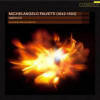Texte paru dans: / Appeared in:

Fanfare Magazine: 37:5 (05-06/2014)
Pour
s'abonner / Subscription information
Les abonnés à Fanfare Magazine ont accès aux archives du
magazine sur internet.
Subscribers to Fanfare Magazine have access to the archives of the magazine
on the net.
Ambronay
AMY 036

3760135100361 (ID346)
Consultez toutes les évaluations recensées pour ce cd
~~~~ Reach all the evaluations located for this CD
Michelangelo Falvetti (1642–1692) doesn’t rate an entry in Grove I, but he was an important musical light in late-17th-century Aragonese Sicily. He took over the post of maestro di cappella at Palermo Cathedral in 1670, and was a founding member there of the Unione dei Musici in 1679, for the promotion of musical exchanges and dialogue. A few years later he moved to Messina, where he was once again put in charge of musical affairs for the regional cathedral.
Very little music of his has made it down to present times in a complete, performable state, at least in part due to natural disasters. (The island is prone to earthquakes. The year after Falvetti’s death it was struck by one that took an estimated 60,000 lives—an immense number for such a relatively small area at the time.) Fortunately, two of his operatic oratorios survive: Il diluvio universale and Nabucco. The former is a retelling of the Biblical Flood, while the latter takes up the story of Nebuchadnezzar II, Daniel, and the three children divinely protected from fiery punishment.
From a continental perspective, Nabucco is a conservative work. The flexibility of its recitative, the simple structure and late-16th-century melodic-harmonic vocabulary of its songs (despite their occasionally overlapping duet and trio vocal lines, sometimes briefly in canon), its consistently danceable rhythms—a product of its courtly ballo ancestry—its mythological prologue (featuring Pride, Idolatry, and the Euphrates), all point back through Provenzale to Cavalli. At a time when Italian opera was becoming increasingly codified into a series of rigid aesthetic formulas, Falvetti reminds one of its earlier, fresher years. Nabucco is a charming piece, and a real find.
Alarcón is the conductor and editor of this unpublished oratorio, but hearing it brings up memories of Leppard’s L’incoronazione di Poppea, more than half a century ago. Alarcón himself writes, “Contemporary documents speak of Vespers by Falvetti, now unfortunately lost, that were performed by all sorts of instruments.” There is no discussion of what “all sorts of instruments” may mean, but Alarcón leaps from that into deciding to “identify the existing instruments most similar to those described in the Bible.” This leads to a plethora of decisions that run contrary to Baroque practice, to put it mildly.
I have to ask whether Falvetti, a Baroque composer, would have used tuned skin drums with slurred pitches in Nabucco’s “Per non vivere infelice”? Added improvised Arabic poly-rhythms under the quartet, “Offransi ini di laude”? Would he have given a woodwind solo to the Persian instrument, the ney, at the start of “S’al Dio d’Israelle”? Or replaced the bowed bass in both “Siamo a riva” and “Di Nabucco in su le chiome” with flutes, providing that part with an unexpected prominence in a manner that layers up textures like a modern orchestra? Would Messina’s cathedral at that time have had access to, and included in its ensemble, a bagpipe, shepherd’s kaval, and pastoral galoubet, not to mention an oboe, flute, lyre, harp, multiple cornetts and sackbuts, organ, harpsichord, and a full complement of violins, a viola, and viola da braccio? I have no criticism of Alarcón’s conducting ability; and I think it fair to state that in Nabucco he has uncovered a delightfully evocative piece that deserves to be far better known. But his intoxication with both exotic and endless timbres has led him into thoroughly anachronistic territory that takes attention away from the music itself. Alarcón doesn’t merely gild the lily, he sets it glowing here in neon lights. It’s wild fun, but a first recording should give us something rather closer to what might be considered an historically probable instrumentation.
That said, the performances are generally fine. While Fernando Guimarães is inclined to slur and slight the full value of notes in fast passagework, he remains an exciting soloist with a bright voice. Alejandro Meerapfel, more basso profundo than bass, phrases expertly as Daniel. Everyone else meets all expectations in this tuneful, occasionally florid music; and for all the Cappella Mediterranea’s extravagant orchestral makeup, they play with discipline and energy.
My reservations about this recording remain, but I can’t fault either score or performance. It’s certainly worth a listen, but I’d still really like to hear Nabucco with the neon lights turned off.
Cliquez l'un ou l'autre
bouton pour découvrir bien d'autres critiques de CD
Click either button for many other reviews


